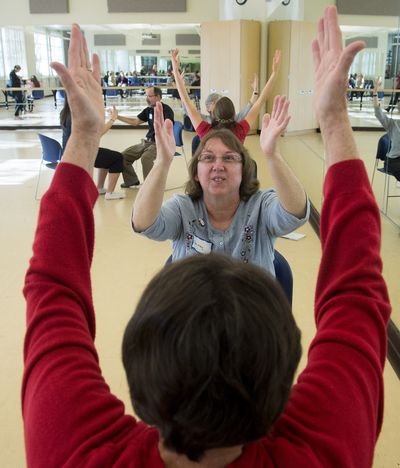Parkinson’s patients explore joy of movement in Gonzaga dance class

The sunlight flows in through tall windows in Gonzaga University’s dance studio, reflecting in the wall-size mirrors and casting shadows on the wood floor.
At the barre, where you’d expect to see ballerinas lined up, sits an older gentleman in a wheelchair and the group gathered along with him is wearing sweaters and pants, looking more like it’s touring campus than getting ready for a dance class.
In walks Suzanne Ostersmith, the director of Gonzaga’s dance program, and soon everyone is seated on chairs in a circle beginning to warm up for the Dance for Parkinson’s class.
It looks a little bit like “Sit and Be Fit,” the public television program where people sit in chairs and work out, except in this class students also warm up faces, squinting, sticking out their tongues and scrunching up their faces much to the joy and laughter of everyone.
The class is open to Parkinson’s disease patients, their caregivers and family,
Sitting on chairs, students begin by making a simple gesture along with saying their name.
Then exercises turn into a series of sitting reaches and stretches, like seated yoga sun salutations.
Students follow as best they can.
“It doesn’t matter if you do it in the right order,” Ostersmith tells them. “Don’t go into some kind of judgment thing – just keep going.”
Shirley Hernandez, who has essential tremors, has been part of the class since its beginning five years ago when she joined with her dad who had Parkinson’s.
“He just loved it,” Hernandez said. “Now he is dead and I come with my mom instead – we just never stopped going.”
From the sitting exercises, class members stand and move over to the barre where they do a series of carefully choreographed steps, plies and turns, accompanied by a pianist.
Cyndi Cook, resource director with Parkinson’s Resource Center of Spokane, said the class offers a multitude of benefits for Parkinson’s patients – the biggest one perhaps being social.
“One thing that happens with Parkinson’s patients is apathy, they have a hard time getting out in the community,” Cook said. “It can be very isolating. Here they know each other and they know they share the disease.”
About 5,000 people in the greater Spokane area have Parkinson’s disease, Cook said.
Most are older than 58 when diagnosed and there’s a tendency for more men than women to get it.
“You can be diagnosed when you are younger, like actor Michael J. Fox,” Cook said, “but that’s unusual.” There is no cure for Parkinson’s, but Cook said that staying active – for instance by exercising or dancing – is key to slowing the progression of the disease.
“There’s something that happens with music and movement that’s very helpful,” Cook said, adding that the class has Parkinson’s patients at all levels. “Some are very mobile. Some are in wheelchairs.”
After returning from special Parkinson’s dance training with the Mark Morris Dance Company in Brooklyn last year, Ostersmith began involving her own students more in the class.
“It’s an excellent way for the students to get a chance to teach,” Ostersmith said. “It allows us to combine the class with our curriculum.”
The class lasts about an hour and is offered weekly on alternating Fridays and Saturdays. Donations are accepted but there is no set fee.
Hernandez is all smiles prior to the class.
“We do feel the benefits,” she said. “How does it feel? It makes us feel good.”